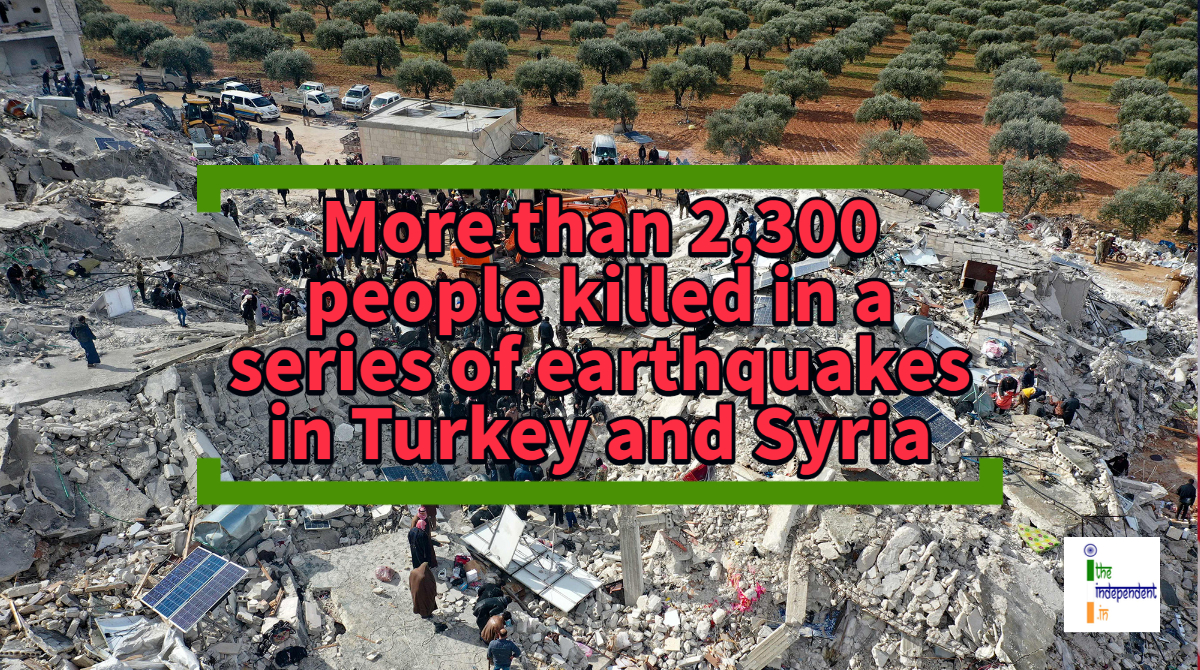
Powerful earthquakes and their aftershocks have killed some 2,300 people and injured thousands more in Turkey and Syria
More than 2,300 people have been killed in a massive earthquake of 7.8 magnitude, followed by another earthquake of 7.5 magnitude, which hit Southeastern Turkey and Northwestern Syria, injuring thousands of others and causing widespread destruction.
Of the 1,900 people, at least 1,498 people are from Turkey and another 810 confirmed fatalities are from Syria. The quakes and aftershocks toppled buildings and sent rescuers scrambling through the rubble to find survivors. The death toll is expected to rise, with experts warning that aftershocks could continue for days or weeks. The Danish geological institute said the tremors were felt as far away as Greenland.
This was the highest magnitude earthquake since 1939, which hit Erzincan Province and killed more than 30,000 people.
Taking it to twitter, the President of Recep Tayyip Erdogan tweeted (translated to English), “We also coordinate the works initiated after the earthquake. We hope that we will get through this disaster together as soon as possible and with the least damage, and we continue our work.” Original tweet in Turkish:
Biz de yaşanan deprem sonrası başlatılan çalışmaları koordine ediyoruz. Yaşadığımız bu felaketi inşallah hep birlikte en kısa sürede ve en az hasarla atlatmayı temenni ediyor, çalışmalarımızı sürdürüyoruz.
— Recep Tayyip Erdoğan (@RTErdogan) February 6, 2023
Meanwhile, the Syrian Civil Defence, a rescue group operating in the opposition-held portions of Northern Syria, declared a state of emergency and appealed for the international community to support the rescue of civilians in Syria.
The President of the European Commission – Ursula von der Leyen tweeted,
We stand in full solidarity with the people of Türkiye and Syria after the deadly earthquake that hit this morning.
— Ursula von der Leyen (@vonderleyen) February 6, 2023
We mourn with the families of the victims.
Europe’s support is already on the way and we stand ready to continue helping in any way we can. https://t.co/inPsoE5hXf
The earthquake occurred at 4:17 a.m. local time (01:17 GMT), with its epicenter in Kahramanmaras in Gaziantep province, about 33kms (20 miles) from the capital city of Gaziantep, which is home to more than 2 million people, including hundreds of thousands of Syrians who fled during the country’s war, which began in 2011.
The United States (U.S.) Geological Survey agency noted that the area contains many buildings constructed of brick masonry or brittle concrete, making them extremely vulnerable to earthquake shaking.
The quake was about 50 kms (31 miles) from the border of Northwest Syria, where about 1.7 million internally displaced Syrians live in a cluster of camps in areas controlled by opposition groups still fighting the Government of Syrian President – Bashar al-Assad. Several large government-controlled cities, including Aleppo, with a dense population of 2 million, are located in the area.
More than 40 aftershocks were felt in the wake of the initial quake, including one with a magnitude of 7.5 that hit at 1:24pm (10:24 GMT) around 4 kms (2.5 miles) South-Southeast of the town of Ekinozu.
An earthquake expert with Turkey’s Academy of Sciences – Naci Gorur urged the local officials to immediately check the region’s dams for cracks to avert potentially catastrophic flooding.
Turkey predominantly sits on the Anatolian Plate, with two major faults, the North Anatolian Fault, which runs between the Anatolian Plate and the Eurasian Plate to the North of Turkey’s land mass, and the East Anatolian Fault, which runs along the Arabian Plate to the Southeast of Turkey’s territory. The geological location makes Turkey one of the world’s most active earthquake zones.
Earlier in 1999, a magnitude 7.4 earthquake hit the Duzce region in Northeastern Turkey, killing more than 17,000 people.







